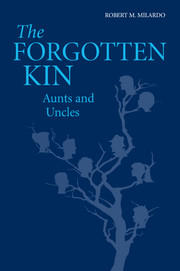Book contents
3 - Describing the Relationships
Published online by Cambridge University Press: 20 January 2010
Summary
In this chapter, I detail the relationships of aunts and nieces, uncles and nephews, describing their essential qualities, including how often they visit and, just as important, how new mediums such as cell phones and e-mail influence their relationships. We explore how families negotiate geographic distances that separate them and continue to engage one another, stay informed of one another's circumstances, and sometimes maintain distinctly close ties. In attempting to cast light on the factors that influence closeness, we explore in greater depth the all-important relationships between adult family members and especially siblings, or the parents of nieces and nephews. We examine the impact of divorce on extended family members and the importance of aunts and uncles in helping children come to understand their parents' marital struggles. Other key features of families can encourage contact and the development of close relationships, including careers and family obligations, personal features such as childlessness, highly valued qualities like being fun, and family values that encourage contact, or fail to do so. Each of these broad features of families and their members illuminate when aunts and uncles are apt to develop extended relationships with their nieces and nephews.
TOGETHER NEAR AND FAR
Aunts, uncles, nieces, and nephews varied widely in their frequency of interaction, from the occasional family gatherings to weekly or even daily contact, and they vary in the purpose of their visits (see Table 3.1).
- Type
- Chapter
- Information
- The Forgotten KinAunts and Uncles, pp. 45 - 69Publisher: Cambridge University PressPrint publication year: 2009



